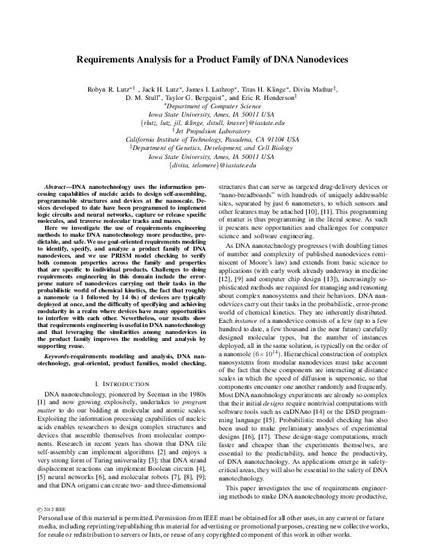
Presentation
Requirements analysis for a product family of DNA nanodevices
Proceedings of the 2012 20th IEEE International Requirements Engineering Conference (RE)
Document Type
Conference Proceeding
Disciplines
Conference
20th IEEE International Requirements Engineering Conference (RE)
Publication Version
Accepted Manuscript
Publication Date
1-1-2012
DOI
10.1109/RE.2012.6345806
Conference Title
20th IEEE International Requirements Engineering Conference (RE)
Conference Date
September 24-28, 2012
Geolocation
(41.8781136, -87.62979819999998)
Abstract
DNA nanotechnology uses the information processing capabilities of nucleic acids to design self-assembling, programmable structures and devices at the nanoscale. Devices developed to date have been programmed to implement logic circuits and neural networks, capture or release specific molecules, and traverse molecular tracks and mazes. Here we investigate the use of requirements engineering methods to make DNA nanotechnology more productive, predictable, and safe. We use goal-oriented requirements modeling to identify, specify, and analyze a product family of DNA nanodevices, and we use PRISM model checking to verify both common properties across the family and properties that are specific to individual products. Challenges to doing requirements engineering in this domain include the error-prone nature of nanodevices carrying out their tasks in the probabilistic world of chemical kinetics, the fact that roughly a nanomole (a 1 followed by 14 0s) of devices are typically deployed at once, and the difficulty of specifying and achieving modularity in a realm where devices have many opportunities to interfere with each other. Nevertheless, our results show that requirements engineering is useful in DNA nanotechnology and that leveraging the similarities among nanodevices in the product family improves the modeling and analysis by supporting reuse.
Rights
© 2012 IEEE. Personal use of this material is permitted. Permission from IEEE must be obtained for all other uses, in any current or future media, including reprinting/republishing this material for advertising or promotional purposes, creating new collective works, for resale or redistribution to servers or lists, or reuse of any copyrighted component of this work in other works.
Copyright Owner
IEEE
Copyright Date
2012
Language
en
File Format
application/pdf
Citation Information
Robyn R. Lutz, Jack H. Lutz, James I. Lathrop, Titus H. Klinge, et al.. "Requirements analysis for a product family of DNA nanodevices" Chicago, Illinois, USAProceedings of the 2012 20th IEEE International Requirements Engineering Conference (RE) (2012) p. 211 - 220 Available at: http://works.bepress.com/robyn-lutz/6/

This is a proceeding from 20th IEEE International Requirements Engineering Conference (RE) (2012): 211, doi: 10.1109/RE.2012.6345806. Posted with permission.